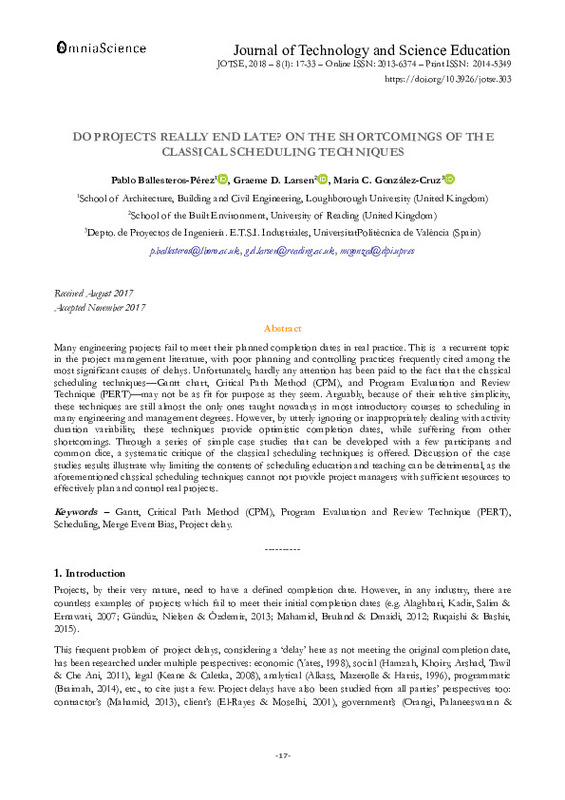JavaScript is disabled for your browser. Some features of this site may not work without it.
Buscar en RiuNet
Listar
Mi cuenta
Estadísticas
Ayuda RiuNet
Admin. UPV
Do Projects really end late? On the shortcomings of the Classical Scheduling Techniques
Mostrar el registro sencillo del ítem
Ficheros en el ítem
| dc.contributor.author | Ballesteros-Pérez, Pablo
|
es_ES |
| dc.contributor.author | Larsen, Graeme D.
|
es_ES |
| dc.contributor.author | González-Cruz, María-Carmen
|
es_ES |
| dc.date.accessioned | 2024-01-17T19:02:37Z | |
| dc.date.available | 2024-01-17T19:02:37Z | |
| dc.date.issued | 2018 | es_ES |
| dc.identifier.issn | 2014-5349 | es_ES |
| dc.identifier.uri | http://hdl.handle.net/10251/201982 | |
| dc.description.abstract | [EN] Many engineering projects fail to meet their planned completion dates in real practice. This is a recurrent topic in the project management literature, with poor planning and controlling practices frequently cited among the most significant causes of delays. Unfortunately, hardly any attention has been paid to the fact that the classical scheduling techniques¿Gantt chart, Critical Path Method (CPM), and Program Evaluation and Review Technique (PERT)¿may not be as fit for purpose as they seem. Arguably, because of their relative simplicity, these techniques are still almost the only ones taught nowadays in most introductory courses to scheduling in many engineering and management degrees. However, by utterly ignoring or inappropriately dealing with activity duration variability, these techniques provide optimistic completion dates, while suffering from other shortcomings. Through a series of simple case studies that can be developed with a few participants and common dice, a systematic critique of the classical scheduling techniques is offered. Discussion of the case studies results illustrate why limiting the contents of scheduling education and teaching can be detrimental, as the aforementioned classical scheduling techniques cannot not provide project managers with sufficient resources to effectively plan and control real projects. | es_ES |
| dc.description.sponsorship | This work was supported by the CIOB Bowen Jenkins Legacy Research Fund under Grant number BLJ2016/BJL.01 at the University of Reading (United Kingdom) | es_ES |
| dc.language | Inglés | es_ES |
| dc.publisher | Omnia Publisher SL | es_ES |
| dc.relation.ispartof | Journal of Technology and Science Education | es_ES |
| dc.rights | Reconocimiento - No comercial (by-nc) | es_ES |
| dc.subject | Gantt | es_ES |
| dc.subject | Critical Path Method (CPM) | es_ES |
| dc.subject | Program Evaluation and Review Technique (PERT) | es_ES |
| dc.subject | Scheduling | es_ES |
| dc.subject | Merge Event Bias | es_ES |
| dc.subject | Project delay | es_ES |
| dc.subject.classification | PROYECTOS DE INGENIERIA | es_ES |
| dc.title | Do Projects really end late? On the shortcomings of the Classical Scheduling Techniques | es_ES |
| dc.type | Artículo | es_ES |
| dc.identifier.doi | 10.3926/jotse.303 | es_ES |
| dc.relation.projectID | info:eu-repo/grantAgreement/CIOB//BLJ2016%2FBJL.01//Bowen Jenkins Legacy Research Fund/ | es_ES |
| dc.rights.accessRights | Abierto | es_ES |
| dc.contributor.affiliation | Universitat Politècnica de València. Escuela Técnica Superior de Ingenieros Industriales - Escola Tècnica Superior d'Enginyers Industrials | es_ES |
| dc.description.bibliographicCitation | Ballesteros-Pérez, P.; Larsen, GD.; González-Cruz, M. (2018). Do Projects really end late? On the shortcomings of the Classical Scheduling Techniques. Journal of Technology and Science Education. 8(1):17-33. https://doi.org/10.3926/jotse.303 | es_ES |
| dc.description.accrualMethod | S | es_ES |
| dc.relation.publisherversion | https://doi.org/10.3926/jotse.303 | es_ES |
| dc.description.upvformatpinicio | 17 | es_ES |
| dc.description.upvformatpfin | 33 | es_ES |
| dc.type.version | info:eu-repo/semantics/publishedVersion | es_ES |
| dc.description.volume | 8 | es_ES |
| dc.description.issue | 1 | es_ES |
| dc.relation.pasarela | S\355113 | es_ES |
| dc.contributor.funder | Chartered Institute of Building | es_ES |
| dc.contributor.funder | Financing body: CIOB (Chartered Institute of Building) at University of Reading (UK). | es_ES |








